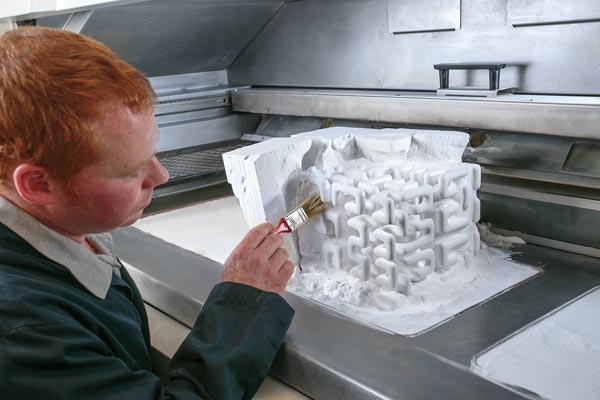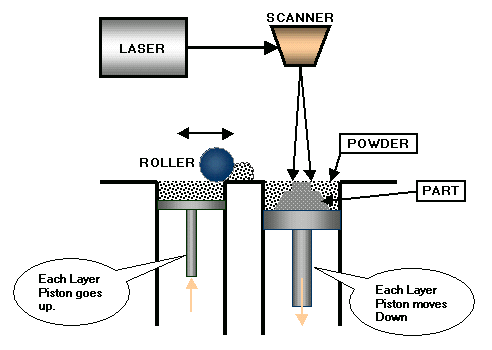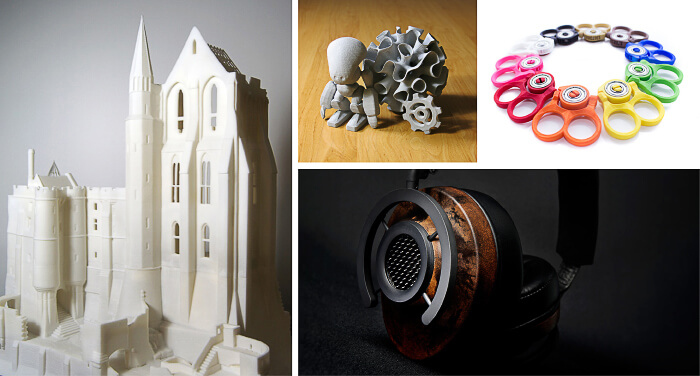Selective Laser Sintering (SLS)
Selective laser sintering (SLS) is an additive manufacturing (AM) technique that uses a laser as the power source to sinter powdered material (typically metal), aiming the laser automatically at points in space defined by a 3D model, binding the material together to create a solid structure. It is similar to direct metal laser sintering (DMLS); the two are instantiations of the same concept but differ in technical details. Selective laser melting (SLM) uses a comparable concept, but in SLM the material is fully melted rather than sintered, allowing different properties (crystal structure, porosity, and so on). SLS (as well as the other mentioned AM techniques) is a relatively new technology that so far has mainly been used for rapid prototyping and for low-volume production of component parts. Production roles are expanding as the commercialization of AM technology improves.
Selective Laser Sintering (SLS) was developed and patented by Dr. Carl Deckard and academic adviser, Dr. Joe Beaman at the University of Texas at Austin in the mid-1980s, under sponsorship of DARPA.
In Selective Layer Sintering, a computer controlled laser pulses down on the platform, tracing a cross-section of the object onto tiny particles of plastic, ceramic or glass. The laser heats the powder either to just below its boiling point (sintering) or above its boiling point (melting), which fuses the particles in the powder together into a solid form. This process continues until the entire object has been printed.
SLS parts are widely used for snap-fit applications. As powder is used for printing the parts; special care needs to be taken while handling these machines. These machines cannot be used in office environment and needs a special environment.
How Does Laser Sintering Work?
Laser Sintering is a laser-based technology that uses solid powder materials, typically plastics. A computer-controlled laser beam selectively binds together particles in the powder bed, by raising the powder temperature above the glass transition point after which adjacent particles flow together. As the powder is self-supporting, no support structures are necessary.
Ideal applications for Laser Sintering
- Prototypes with mechanical properties to rival those of injection-molded parts
- Series of small components as a cost-effective alternative to injection molding
- Large and complex functional parts up to 700 x 380 x 580 mm in one piece
- Personalized manufacturing, the economical production of unique, complex, designs built as one-off products or in small batches
- Lightweight designs using complex lattice structures
Companies using SLS
- 3D Systems Inc.is the company most often associated with SLS printing in the United States. The company prints build-to-order parts for customers, but it also sells its SLS machines for use in business and manufacturing.
- There are also many companiesaround the United States that use SLS machines to provide their clients with high-quality prototypes and finished parts.
- There are many companies all over India that have adopted SLS machines for prototypes and functional objects.
Unique Facts about SLS Technology
Firstly, Selective Laser Sintering is a more affordable additive manufacturing technology than many other 3D printing techniques such as Stereolithography and Fused Deposition Modeling (FDM). Therefore widespread use of the technology will bring us closer to make 3D printing a mainstream technology because the costs involved will be greatly mitigated.
Secondly, unlike quite a number of additive manufacturing technologies which are only reliable for making prototypes; SLS can be used for making both Quality Prototypes and final products. This is why with the major patents expiring this year hence many more companies being allowed access to the technology, it will be only a matter of time before real and worthy final products made Using Additive Manufacturing can begin to be sold directly to consumers.
The unparalleled ability of this technology in making final products can also be attributed to the fact that it is capable of using a rather diverse array of printing materials. While most technologies only rely on plastic materials; Selective Laser Sintering can use plastic, glass, ceramics and even metal. This also makes it easier for SLS to be used in creating customized consumer final products.
Selective Laser Sintering additionally is a more time efficient technique unlike Stereolithography and FDM. The reason being it does not necessarily require additional supports to hold the object in position as it is being printed. Moreover, SLS often requires negligible additional tooling if any, so any objects coming out of the SLS machine do not have to be prepared any further for selling or presentation




